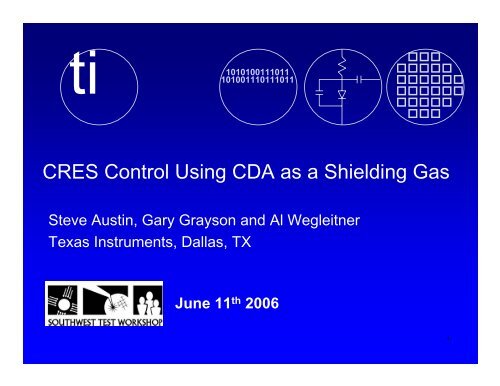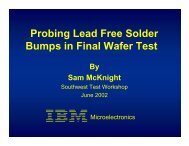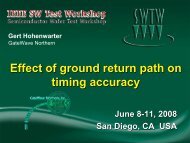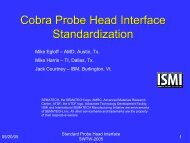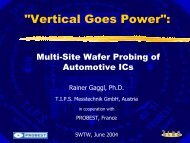CRES Control Using CDA as a Shielding Gas
CRES Control Using CDA as a Shielding Gas
CRES Control Using CDA as a Shielding Gas
You also want an ePaper? Increase the reach of your titles
YUMPU automatically turns print PDFs into web optimized ePapers that Google loves.
ti<br />
1010100111011<br />
101001110111011<br />
<strong>CRES</strong> <strong>Control</strong> <strong>Using</strong> <strong>CDA</strong> <strong>as</strong> a <strong>Shielding</strong> G<strong>as</strong><br />
Steve Austin, Gary Grayson and Al Wegleitner<br />
Tex<strong>as</strong> Instruments, Dall<strong>as</strong>, TX<br />
June 11 th 2006<br />
1
Outline<br />
•Background – the journey<br />
•Problem Statement<br />
•Me<strong>as</strong>urement/Methodology<br />
•Key Findings<br />
•Solution's<br />
•Acknowledgments<br />
SWTW June 11 th 2006<br />
Page 2<br />
Wegleitner et al.
Background<br />
•Factory Expansion Ph<strong>as</strong>e 4 – just<br />
completed<br />
•Ph<strong>as</strong>e 4 automotive factory w<strong>as</strong><br />
experiencing significant CRes yield loss<br />
issues between testers and devices<br />
•Ph<strong>as</strong>e 5 to ramping ~ 150 systems<br />
migrating to automotive 3 insertion test<br />
methodology<br />
SWTW June 11 th 2006<br />
Page 3<br />
Wegleitner et al.
Problem Statement<br />
•Factory w<strong>as</strong> experiencing significant CRes<br />
yield loss issues between testers and<br />
devices during 3 insertion probing<br />
sequence at different temps<br />
•CRes fails were causing significant yield<br />
loss and requiring significant reprobe time<br />
losses<br />
•Traditional CRes solutions were reaching<br />
the limits of effectiveness<br />
SWTW June 11 th 2006<br />
Page 4<br />
Wegleitner et al.
Objective<br />
•Show the effects of <strong>CDA</strong> on CRes<br />
•Review the potential impact of <strong>CDA</strong> that<br />
effect die temperature<br />
•Review design/hardware procedures<br />
needed to manage <strong>CDA</strong><br />
•Share key learning's – the journey<br />
SWTW June 11 th 2006<br />
Page 5<br />
Wegleitner et al.
CRes Sources<br />
Probe<br />
Bond Pad Surface<br />
Test Program<br />
Diode Structure<br />
PC Planarity<br />
Cleaning Frequency<br />
Debris Field<br />
Test Head Level<br />
Z-Axis Travel<br />
Chuck Speed<br />
Muffin Fans<br />
Air Handlers<br />
Raised Floor<br />
Equipment Density<br />
H 2 0 ?<br />
Conditions<br />
that effect<br />
CRes<br />
500<br />
450<br />
400<br />
M<br />
a<br />
x<br />
C<br />
R<br />
E<br />
S<br />
i<br />
n<br />
O<br />
h<br />
m<br />
s<br />
350<br />
300<br />
250<br />
200<br />
150<br />
100<br />
50<br />
0<br />
Typical <strong>CRES</strong> performance<br />
curve in SCT and EBT.<br />
VLB105<br />
~ 7 ohms<br />
~ 7 minutes<br />
SWTW June 11 th 2006<br />
Page 6<br />
Wegleitner et al.
Cres Causes by Category<br />
Nearly all are out of the control of<br />
operations<br />
SWTW June 11 th 2006<br />
Page 7<br />
Wegleitner et al.
Cleaning Frequency change most common<br />
approach to control <strong>CRES</strong> at probe.<br />
SWTW June 11 th 2006<br />
Page 8<br />
Wegleitner et al.
Cleaning Effectiveness<br />
•A Paradigm Shift<br />
◦Improving Contact Resistance without<br />
Incre<strong>as</strong>ing on-line Cleaning?<br />
•Injecting Compressed Dry Air (<strong>CDA</strong>) on the Die<br />
Under Test h<strong>as</strong> improved the stability of <strong>CRES</strong> and<br />
reduces the need for additional on-line cleaning<br />
SWTW June 11 th 2006<br />
Page 9<br />
Wegleitner et al.
Discovery Experiments<br />
•Blanket Aluminum Wafer<br />
•Cantilever Dual-Site Probe Card<br />
•VLCLT Tester<br />
•<strong>CDA</strong><br />
•Nitrogen<br />
•Maximum Contact Resistance<br />
(MAX<strong>CRES</strong>) used to plot effects<br />
SWTW June 11 th 2006<br />
Page 10<br />
Wegleitner et al.
Single Power Pin Maximum Contact<br />
Resistance (MAX<strong>CRES</strong>)<br />
10 Ω 20 Ω<br />
Probe<br />
Card<br />
Needles<br />
13 Ω<br />
Die Under Test<br />
12 Ω<br />
11 Ω<br />
12 Ω<br />
SWTW June 11 th 2006<br />
Page 11<br />
Wegleitner et al.
100<br />
Max Contact Resistance wo/w <strong>CDA</strong><br />
No <strong>CDA</strong> <strong>CDA</strong><br />
90<br />
80<br />
70<br />
Ohms Contact Resistance<br />
60<br />
50<br />
40<br />
30<br />
20<br />
10<br />
0<br />
SWTW June 11 th 2006<br />
Page 12<br />
600 Die 600 Die<br />
Wegleitner et al.
Effectiveness of <strong>CDA</strong> vs. Nitrogen Purge<br />
10.00<br />
9.00<br />
Induced<br />
vibration<br />
8.00<br />
7.00<br />
6.00<br />
Normal<br />
<strong>CDA</strong><br />
Nitrogen<br />
5.00<br />
4.00<br />
3.00<br />
1 7 13 19 25 31 37 43 49 55 61 67 73 79 85 91 97 103 109 115 121 127 133 139 145 151<br />
SWTW June 11 th 2006<br />
Page 13<br />
Wegleitner et al.
Oxidation Theory<br />
• Consider the Mechanical Contact to Al Pads<br />
◦ A native oxide layer of Al2O3 exists on the Al pads to be tested at probe<br />
◦ Some of this native oxide is removed by the mechanical probing & good<br />
contact is made by mechanical abr<strong>as</strong>ion<br />
◦ However, once micro-contacts are made, local heating can lead to oxide<br />
growth in the presence of air, leading to the formation of Al2O3 ( GT° ~ -<br />
400kcal, therefore spontaneous)<br />
◦ In the presence of moisture, hydrated aluminum oxides (Al2O3+H2O)<br />
are formed which can be thicker & more porous than the native Al2O3<br />
◦ The hydrated oxides are colorless to white and can lead to resistive or<br />
semiconducting contacts 1<br />
• <strong>CDA</strong> Purge Effects on Contact Process<br />
◦ Elimination of moisture and therefore, hydration of the oxide<br />
1<br />
Broz & Rincon, “Probe Contact Resistance During Elevated<br />
Temperature Wafer Test,” ITC Proceedings, p. 396, 1999.<br />
SWTW June 11 th 2006<br />
Page 14<br />
Wegleitner et al.
<strong>CDA</strong> Contamination Within Factory Specs.<br />
• Moisture readings pre and post filter (Spec ~ 100 ppm)<br />
◦ Pre filter w<strong>as</strong> at 9.02 ppm after 14 hours of analysis<br />
◦ Post filter w<strong>as</strong> at 10.8 ppm and dropping after only 2 hours of<br />
analysis<br />
• Hydrocarbon (THC) readings from pre and post filter<br />
(Spec ~ 5 ppm)<br />
◦ Both Samples were analyzed using a GC/FID for total<br />
hydrocarbons (THC) <strong>as</strong> CH4 per the site specification for <strong>CDA</strong><br />
◦ The pre filter sample averaged 3.26 ppm THC <strong>as</strong> CH4<br />
◦ The post filter sample averaged 3.46 ppm THC <strong>as</strong> CH4<br />
SWTW June 11 th 2006<br />
Page 15<br />
Wegleitner et al.
SWTW June 11 th 2006<br />
Page 16<br />
Wegleitner et al.
<strong>CDA</strong> vs. Non - <strong>CDA</strong> Results<br />
MP3 Yield Percentage With and Without <strong>CDA</strong><br />
BIN<br />
228<br />
227<br />
224<br />
100.0%<br />
95.0%<br />
Count of DIE_NUM<br />
222<br />
221<br />
220<br />
215<br />
90.0%<br />
85.0%<br />
202<br />
201<br />
178<br />
80.0%<br />
75.0%<br />
76<br />
74<br />
66<br />
70.0%<br />
65.0%<br />
65<br />
56<br />
55<br />
60.0%<br />
55.0%<br />
54<br />
53<br />
49<br />
50.0%<br />
45.0%<br />
47<br />
46<br />
43<br />
40.0%<br />
35.0%<br />
41<br />
39<br />
38<br />
30.0%<br />
D-<br />
D-<br />
D-<br />
D-<br />
D-<br />
D-<br />
D-<br />
D-<br />
D-<br />
D-<br />
D-<br />
D-<br />
D-<br />
D-<br />
D-<br />
D-<br />
D-<br />
D-<br />
D-<br />
D-<br />
D-<br />
D-<br />
D-<br />
D-<br />
D-<br />
D-<br />
D-<br />
D-<br />
D-<br />
D-<br />
D-<br />
D-<br />
D-<br />
D-<br />
D-<br />
D-<br />
D-<br />
D-<br />
D-<br />
D-<br />
D-<br />
D-<br />
D-<br />
D-<br />
D-<br />
D-<br />
D-<br />
37<br />
35<br />
129C<br />
<strong>CDA</strong><br />
V3D620B09<strong>CDA</strong><br />
125C<br />
<strong>CDA</strong> Off<br />
V3D620B09<br />
31<br />
21<br />
20<br />
12<br />
0<br />
PROBE_CNT PROG <strong>CDA</strong>_ON TEMP WAFER<br />
11<br />
1<br />
SWTW June 11 th 2006<br />
Page 17<br />
Wegleitner et al.
<strong>CDA</strong> vs. Non - <strong>CDA</strong> Results<br />
Contact Sensitive Fallout (Bins 41, 55, 74, and 201) With and Without <strong>CDA</strong><br />
180<br />
Count of DIE_NUM<br />
170<br />
160<br />
150<br />
140<br />
130<br />
120<br />
110<br />
100<br />
90<br />
80<br />
70<br />
BIN<br />
201<br />
74<br />
55<br />
41<br />
60<br />
50<br />
40<br />
30<br />
20<br />
10<br />
0<br />
D-<br />
D-<br />
D-<br />
D-<br />
D-<br />
D-<br />
D-<br />
D-<br />
D-<br />
D-<br />
D-<br />
D-<br />
D-<br />
D-<br />
D-<br />
D-<br />
D-<br />
D-<br />
D-<br />
D-<br />
D-<br />
D-<br />
D-<br />
D-<br />
D-<br />
D-<br />
D-<br />
D-<br />
D-<br />
D-<br />
D-<br />
D-<br />
D-<br />
D-<br />
D-<br />
D-<br />
D-<br />
D-<br />
D-<br />
D-<br />
D-<br />
D-<br />
D-<br />
D-<br />
D-<br />
D-<br />
D-<br />
129C<br />
<strong>CDA</strong><br />
V3D620B09<strong>CDA</strong><br />
125C<br />
<strong>CDA</strong> Off<br />
V3D620B09<br />
0<br />
PROBE_CNT PROG <strong>CDA</strong>_ON TEMP WAFER<br />
SWTW June 11 th 2006<br />
Page 18<br />
Wegleitner et al.
BIN<br />
201<br />
74<br />
55<br />
D-<br />
4334196-<br />
22<br />
D-<br />
4334196-<br />
17<br />
80<br />
70<br />
60<br />
SWTW June 11 th 2006<br />
Page 19<br />
Wegleitner et al.<br />
50<br />
40<br />
30<br />
20<br />
10<br />
0<br />
<strong>CDA</strong> vs. Non - <strong>CDA</strong> Results<br />
Contact Sensiive Fallout (Bins 41, 55, 74, and 201) With and Without <strong>CDA</strong><br />
Count of DIE_NUM<br />
D-<br />
4334196-<br />
03<br />
D-<br />
4334196-<br />
09<br />
D-<br />
4334196-<br />
23<br />
D-<br />
4334196-<br />
07<br />
D-<br />
4334196-<br />
10<br />
D-<br />
4334196-<br />
24<br />
D-<br />
4334196-<br />
02<br />
D-<br />
4334196-<br />
06<br />
D-<br />
4334196-<br />
14<br />
D-<br />
4334196-<br />
15<br />
D-<br />
4334196-<br />
20<br />
D-<br />
4334196-<br />
21<br />
D-<br />
4334196-<br />
01<br />
D-<br />
4334196-<br />
04<br />
D-<br />
4334196-<br />
05<br />
D-<br />
4334196-<br />
11<br />
D-<br />
4334196-<br />
13<br />
VLB160 VLC45 VLC93<br />
129C 125C<br />
<strong>CDA</strong> No <strong>CDA</strong><br />
V3D944X03<strong>CDA</strong> V3D944X03<br />
0<br />
41<br />
PROBE_CNT PROG <strong>CDA</strong> ON TEMP TESTER WAFER
<strong>CDA</strong> influence on die temperature<br />
• Response of ICCQ to chuck temperature w<strong>as</strong><br />
characterized with no <strong>CDA</strong>.<br />
• <strong>CDA</strong> w<strong>as</strong> injected at room temp (30°C) and hot<br />
chuck(125°C). Changes in ICCQ were recorded<br />
• The equation (<strong>CDA</strong> Temp – Chuck Temp) / 45°C<br />
closely defines the effect of <strong>CDA</strong> on die temperature.<br />
◦<strong>CDA</strong> temperature is 20°C typical<br />
◦Die temp is effected by
Effect of chuck temperature on ICCQ current<br />
uA<br />
ICCQ<br />
Current<br />
Dev A<br />
Dev B<br />
Chuck Temperature<br />
SWTW June 11 th 2006<br />
Page 21<br />
Wegleitner et al.
<strong>CDA</strong> Hardware Example<br />
SWTW June 11 th 2006<br />
Page 22<br />
Wegleitner et al.
No Me<strong>as</strong>urable ESD Buildup<br />
• Me<strong>as</strong>ured ESD on probe needles<br />
◦ACL Model 300B Electrostatic Locator<br />
•Two testers<br />
•<strong>CDA</strong> on needles<br />
•Me<strong>as</strong>ure every 15 minutes<br />
◦No Me<strong>as</strong>urable static build up
0.90%<br />
0.80%<br />
0.70%<br />
0.60%<br />
0.50%<br />
% Opens<br />
0.40%<br />
SWTW June 11 th 2006<br />
Page 24<br />
0.30%<br />
Wegleitner et al.<br />
Contact Stability - By Week<br />
Opens Before/After Immediate Reprobe - First Probe in EBT/SCT<br />
70%<br />
60%<br />
50%<br />
40%<br />
30%<br />
20%<br />
10%<br />
0.20%<br />
0%<br />
0.10%<br />
0.00%<br />
20-Feb<br />
18-Feb<br />
May-Wk1<br />
May-Wk3<br />
Jun-Wk1<br />
Jun-Wk3<br />
Jun-Wk5<br />
Ju1-Wk2<br />
Ju1-Wk4<br />
Aug-Wk2<br />
Aug-Wk4<br />
Sep-Wk2<br />
Sep-Wk4<br />
Oct-Wk1<br />
Oct-Wk3<br />
Nov-Wk1<br />
Nov-Wk3<br />
Dec-Wk1<br />
Dec-Wk3<br />
Dec-Wk5<br />
Jan-Wk2<br />
Jan-Wk4<br />
Feb-Wk2<br />
Impact on First P<strong>as</strong>s Opens<br />
<strong>CDA</strong><br />
Turned<br />
On<br />
% Opens Before Reprobe<br />
(right axis)<br />
% Opens After Reprobe<br />
(right axis)<br />
Goal for % Changed<br />
% Opens Changed
Conclusion<br />
• An in-situ method of stabilizing contact resistance<br />
using <strong>CDA</strong> (compressed dry air)<br />
• Reducing oxidation and contaminate build up<br />
• Maximizing yield and reducing reprobe on contact<br />
sensitive BINs<br />
• Reduces the need to incre<strong>as</strong>e cleaning intervals. This<br />
results in longer probe card life and improved<br />
throughput.<br />
SWTW June 11 th 2006<br />
Page 25<br />
Wegleitner et al.
Acknowledgements<br />
•Steve Austin<br />
•Kelly Daughtry<br />
•Gary Grayson<br />
•Frank Mesa<br />
•Mark Gillette<br />
•Robert Davis<br />
•PE Techs<br />
SWTW June 11 th 2006<br />
Page 26<br />
Wegleitner et al.
Thanks For Listening –<br />
Enjoy the Conference<br />
SWTW June 11 th 2006<br />
Page 27<br />
Wegleitner et al.


